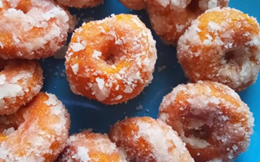ARTS AND CULTURE INFORMATION GATEWAY
Immerse yourself in the colorful world of art and culture! From traditional heritage to contemporary works, discover uniqueness that reflects the nation's identity and identity
KUIH KERIA
Picture
1
Video
No record
Today's Visitor
7
Number of Visitors
1398
Introduction and history
Kuih Keria is one of the traditional Malay delicacies that is very popular in Malaysia, Indonesia, and Brunei. This snack is shaped like a donut but made from sweet potatoes and coated with palm sugar (gula melaka) or regular sugar. The name "Kuih Keria" is believed to originate from the word "keria," which refers to the circular shape of this kuih with a hole in the middle, resembling a wheel or a ring.
In the Malay dialect, this shape is often associated with the word "keria," meaning round or a small wheel. Kuih Keria is thought to have originated from the traditional diet of the Malay community in the past when sweet potatoes were widely used as a staple food. Sweet potatoes were often used in cooking and desserts due to their availability, affordability, and nutritional value. The recipe for Kuih Keria is said to have started as an alternative snack made with basic local ingredients, such as sweet potatoes, wheat flour, and sugar. Although its exact origins are not clearly documented, Kuih Keria has become an important part of the culinary culture of the Nusantara region.
Traditional Kuih Keria uses melted sugar as a coating to create a shiny, sweet glaze. This older version is commonly found in traditional markets. Later, a variation using melted palm sugar (gula melaka) was introduced, giving it a unique caramel flavor. This version is particularly famous in Melaka, especially in areas like Limbongan. The "Kuih Keria Antarabangsa Limbongan" became well-known for its special recipe, which offers a soft texture and a rich palm sugar coating.
The role of Kuih Keria can be observed from several aspects, especially in the context of culture, food, and community life.
1. A Light Snack
o Kuih Keria serves as a light snack often enjoyed during leisure time, especially during afternoon tea with family or friends. It is also a popular dessert after meals.
2. Tourism Icon and Cultural Promotion
o Kuih Keria Gula Melaka has become a tourist attraction in Melaka. Visitors from within and outside the country often seek it as a unique culinary experience. In this way, Kuih Keria helps promote Malaysia as a destination for traditional foods.
-
• 600g white or red sweet potatoes
• 1¼ cups wheat flour
• 1 teaspoon salt
For the syrup coating:
• ½ cup sugar
• 1 cup water
For Kuih Keria:
1. Cut the sweet potatoes into 2 or 3 parts. Boil the sweet potatoes with salt until tender.
2. Cool the sweet potatoes, remove their skins, and mash until smooth and free of lumps. Gradually add flour until the mixture forms a dough that can be shaped.
3. Shape the dough into rounds and make a hole in the middle. Fry until golden brown.
For the Sugar Coating:
1. Combine sugar and water in a pot. Cook until thickened, then coat the fried sweet potatoes in the syrup, ensuring they are fully covered.
2. Cool before serving.
Tips:
• Add flour gradually to prevent the dough from becoming too hard due to excess flour.
-
Reference Source
i. Bahan Bacaan
Wan Ramli, N. (2010). Makanan Tradisional Melayu: Warisan dan Budaya. Kuala Lumpur: Dewan Bahasa dan Pustaka.
Ismail, Z., & Hassan, R. (2015). Resepi Kuih Tradisional Malaysia. Shah Alam: Karangkraf.
Rahman, F., & Aziz, M. (2018). "Pengaruh Makanan Tradisional dalam Menyatukan Komuniti di Malaysia." Jurnal Warisan Budaya, 12(3), 45-53.
Ahmad, R. (2020). "Evolusi Kuih Keria Gula Melaka Sebagai Produk Pelancongan Melaka." Jurnal Makanan & Pelancongan, 5(1), 15-25.
Location
State JKKN Contact Information
Nur Al-Farani binti Rosli
Cultural Officer
Jabatan Kebudayaan dan Kesenian Negara, Melaka
Kompleks JKKN Melaka
Hang Tuah Jaya, Lebuh Ayer Keroh,
75450 MELAKA
06 - 763 6308
Use the form below to contact the Informant/Figure/Editor/Researcher directly. We will respond to your inquiry as soon as possible!








